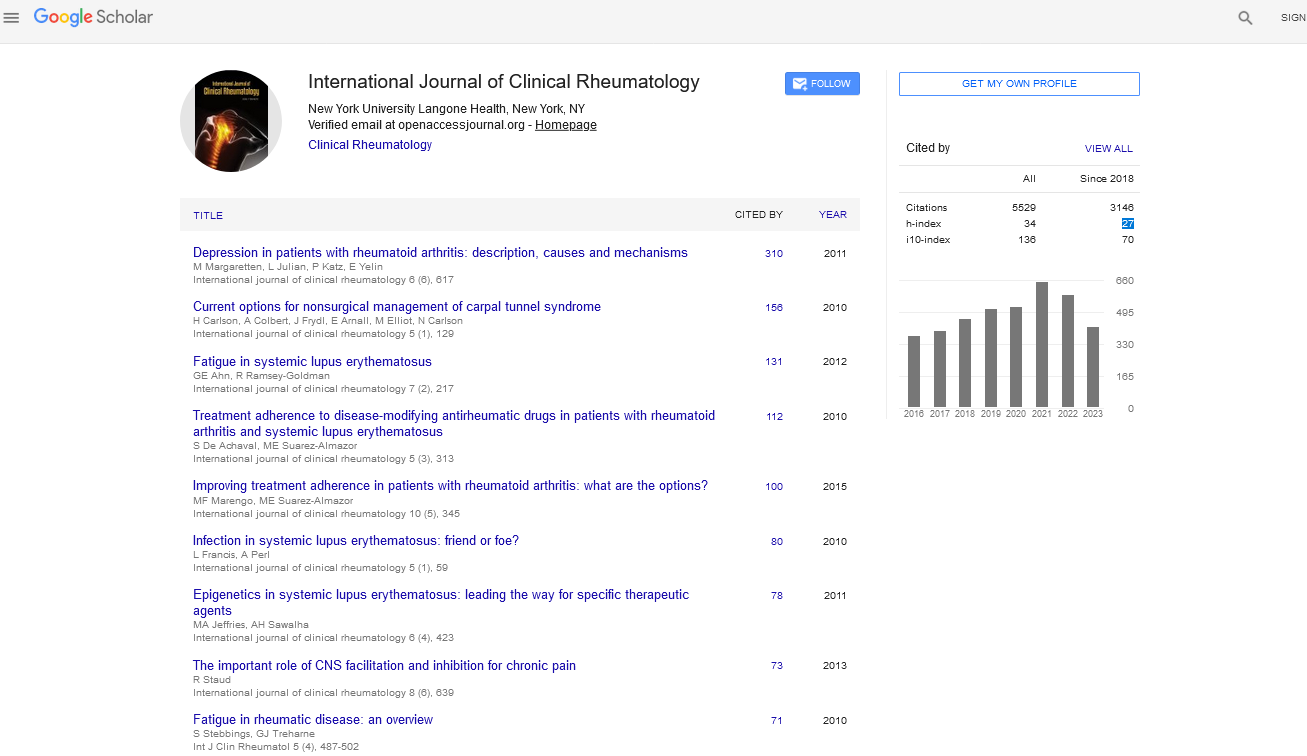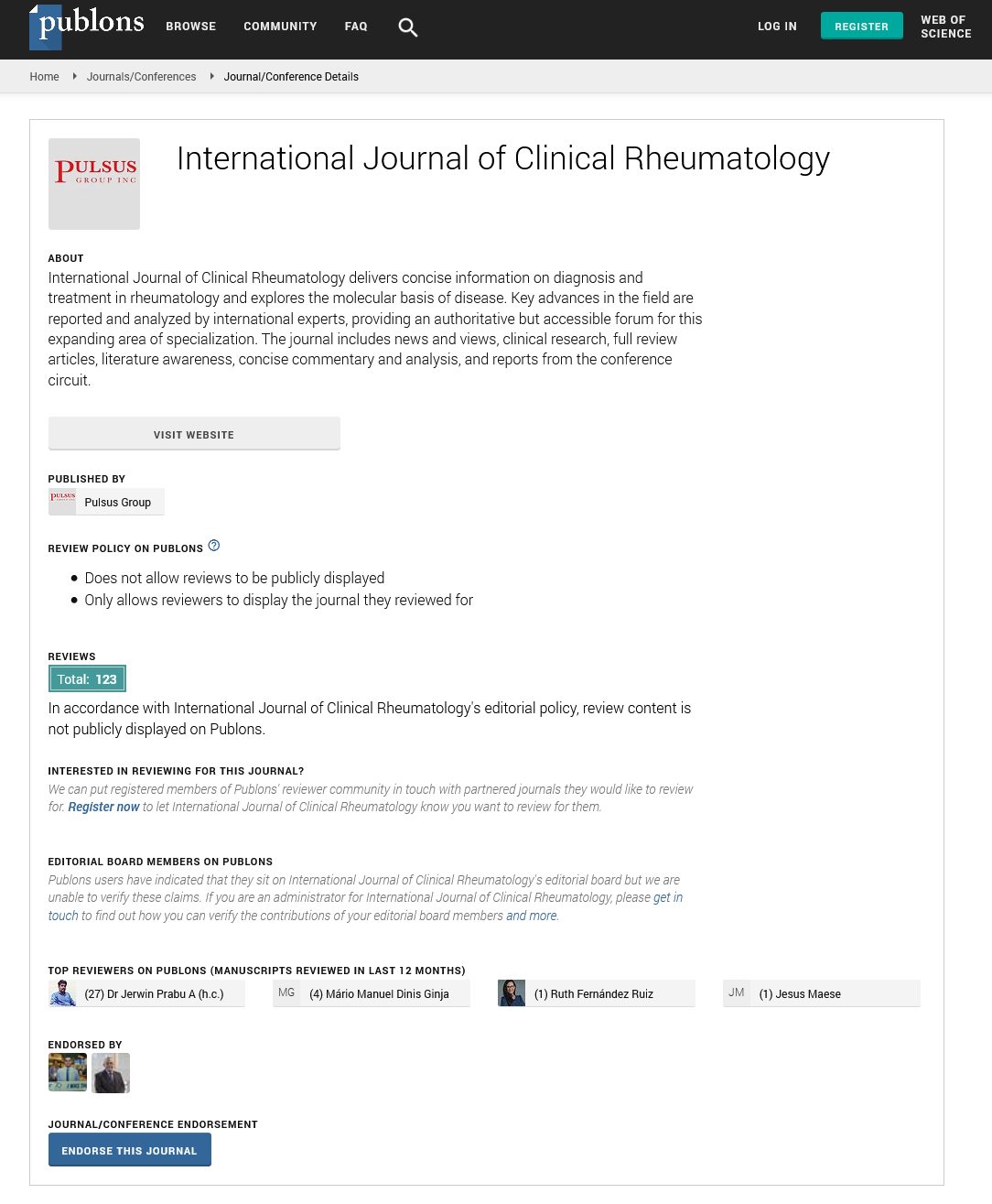Perspective - International Journal of Clinical Rheumatology (2025) Volume 20, Issue 1
Advances in the Diagnosis and Treatment of Systemic Lupus Erythematosus (SLE)
Mia Turner*
Department of Rheumatology, Hacettepe University, Ankara, Turkey
- *Corresponding Author:
- Mia Turner
Department of Rheumatology, Hacettepe University, Ankara, Turkey
E-mail: mia.turner04@gmail.com
Received: 02-Jan-2025, Manuscript No. fmijcr-25-162971; Editor assigned: 04- Jan-2025, Pre-QC No. fmijcr-25-162971 (PQ); Reviewed: 18-Jan-2025, QC No. fmijcr-25-162971; Revised: 23-Jan-2025, Manuscript No. fmijcr-25-162971 (R); Published: 30-Jan-2025, DOI: 10.37532/1758- 4272.2025.20(1).390-393
Abstract
Systemic lupus erythematosus (SLE) is a chronic autoimmune disease that can affect multiple organs, leading to significant morbidity and mortality. Despite being recognized for centuries, the complexity of its pathogenesis, heterogeneous clinical presentation, and fluctuating disease course pose substantial challenges in its diagnosis and management. Advances in the understanding of SLE's immunologic mechanisms, the identification of novel biomarkers, and the development of targeted therapies have significantly altered the treatment landscape. This article reviews the current diagnostic criteria, emerging biomarkers, and new treatments for SLE, with an emphasis on biologic therapies such as belimumab, anifrolumab, and other promising interventions. We also discuss the impact of personalized medicine and precision healthcare in optimizing patient care. While these advancements hold promise for improved clinical outcomes, further research is essential to address gaps in early diagnosis, effective disease monitoring, and long-term management strategies.
Keywords
Systemic lupus erythematosus• SLE• Autoimmune disease• Biomarkers• Biologic therapies• Belimumab• Immunologic mechanisms• Personalized medicine• Diagnostics• Treatment advances
Introduction
Systemic lupus erythematosus (SLE) is a chronic, multi-organ autoimmune disorder characterized by the production of autoantibodies against nuclear and cytoplasmic components. It predominantly affects young women and can result in significant morbidity, especially when major organs like the kidneys, heart, or lungs are involved. The clinical manifestations of SLE are highly variable, ranging from mild symptoms such as skin rashes and fatigue to life-threatening complications like lupus nephritis or central nervous system involvement. This heterogeneity, combined with the lack of a single definitive diagnostic test, makes early diagnosis and disease management challenging. In recent years, advancements in the understanding of SLE's pathophysiology, alongside the discovery of novel biomarkers and the development of targeted biologic therapies, have significantly improved treatment outcomes. Conventional therapies, such as corticosteroids and immunosuppressive drugs, have been used for decades, but newer biologics like belimumab and anifrolumab have demonstrated efficacy in reducing disease activity and preventing flares. Personalized medicine, which tailors treatment strategies to individual patient characteristics, is emerging as a critical approach in SLE management. This article reviews the current state of SLE diagnosis, the role of emerging biomarkers, and the latest therapeutic advances, focusing on the implications for clinical practice [1-4].
Advances in diagnosis
The diagnosis of SLE remains challenging due to the absence of a single, reliable biomarker. Traditionally, the diagnosis has relied on clinical criteria, such as the presence of characteristic symptoms (e.g., malar rash, photosensitivity, and oral ulcers) and positive serological tests (e.g., antinuclear antibodies [ANA], anti-dsDNA antibodies). The American College of Rheumatology (ACR) and the Systemic Lupus International Collaborating Clinics (SLICC) have developed classification criteria to assist with diagnosis, but these are not designed for early detection. Recent advances in biomarker research have led to the identification of novel markers that may improve diagnostic sensitivity and specificity. For example, the type I interferon (IFN) signature, characterized by the overexpression of interferon-regulated genes, has been identified as a potential biomarker for SLE, especially in patients with mild or undifferentiated disease. Additionally, autoantibodies against specific proteins, such as anti-Ro, anti-La, and anti-phospholipid antibodies, have been associated with specific disease subsets, such as cutaneous lupus or lupus nephritis. Imaging techniques, including ultrasound and magnetic resonance imaging (MRI), are increasingly being used to assess organ involvement, particularly in the detection of lupus nephritis. These tools can help monitor disease progression and detect early organ damage, even before clinical symptoms appear [5-7].
Therapeutic advances: Over the last decade, the treatment of SLE has evolved with the introduction of biologic agents that specifically target immune pathways involved in disease pathogenesis. Belimumab, a monoclonal antibody that inhibits B-cell activating factor (BAFF), was the first biologic approved for SLE. Belimumab has demonstrated efficacy in reducing disease activity and the frequency of flares, particularly in patients with active, autoantibody-positive disease who have not responded to conventional therapies. Anifrolumab, a monoclonal antibody targeting the type I interferon receptor, has shown promising results in phase III trials. By blocking the overactive interferon signaling, anifrolumab reduces inflammation and prevents damage in multiple organ systems affected by SLE. Studies have shown that anifrolumab is particularly beneficial for patients with moderate-to-severe SLE who have failed standard treatments. Other biologics under investigation include rituximab (which targets CD20-positive B cells), and JAK inhibitors, such as tofacitinib, which target intracellular signaling pathways involved in immune cell activation. While these therapies are still being evaluated in clinical trials, early results suggest they may offer additional treatment options for patients with refractory SLE. In addition to biologics, advances in immunosuppressive therapies, such as low-dose methotrexate, mycophenolate mofetil, and cyclophosphamide, remain critical for managing severe disease manifestations like lupus nephritis. Novel immunosuppressive agents with a more targeted action are currently under development.
Personalized medicine and precision healthcare
The concept of personalized medicine is particularly relevant in SLE due to the heterogeneity of the disease. With the identification of specific genetic, epigenetic, and immunologic markers, it is becoming increasingly feasible to tailor treatments based on an individual’s disease subtype, immune profile, and response to therapy. For example, genetic testing can identify patients at higher risk of adverse drug reactions or those more likely to respond to specific biologic therapies. Precision medicine in SLE involves not only selecting the most effective treatment but also monitoring disease progression and tailoring the treatment plan accordingly. This approach could reduce the risk of flares, improve long-term outcomes, and minimize adverse effects.
Discussion
The management of SLE has undergone significant improvements over the last few years, with substantial advancements in both diagnostic tools and treatment options. Early diagnosis remains one of the major challenges in SLE, as its presentation is often nonspecific, and clinical manifestations can overlap with other autoimmune diseases. The identification of novel biomarkers, such as the type I interferon signature and specific autoantibodies, has provided valuable insights into disease pathogenesis and holds promise for improving early detection and disease monitoring. Biologic therapies, such as belimumab and anifrolumab, represent a major breakthrough in SLE treatment. These therapies target key immune pathways involved in disease progression, offering better disease control, fewer flares, and improved quality of life for patients with moderate-to-severe disease. However, the use of biologics comes with challenges, including high costs and the need for careful monitoring of adverse effects. As the role of biologics expands, long-term data on their safety and efficacy are essential to ensure optimal patient outcomes. Precision medicine is set to revolutionize SLE treatment by tailoring therapies to individual patient profiles. The use of genetic testing and immune profiling may lead to more targeted and personalized therapeutic strategies, ultimately improving the management of SLE. However, widespread implementation of personalized medicine requires addressing issues related to cost, access to advanced diagnostic tools, and physician training [8-10].
Conclusion
Advances in the understanding of SLE’s pathophysiology, the identification of novel biomarkers, and the development of biologic therapies have significantly improved the management of this complex autoimmune disease. Biologic agents such as belimumab and anifrolumab offer new hope for patients with refractory disease, while personalized medicine holds the potential to further optimize treatment outcomes. However, challenges remain in terms of early diagnosis, long-term safety of biologics, and access to cutting-edge treatments. Continued research and clinical trials are essential to refine therapeutic strategies and ensure that all patients with SLE benefit from these advances in diagnosis and treatment.
References
- Negus RPM,JW Stamp,Hadley J et al. Quantitative assessment of the leukocyte infiltrate in ovarian cancer and its relationship to the expression of C-C chemokines. Am J Pathol. 150, 1723-1734 (1997).
- Henze AT,Mazzone M. The impact of hypoxia on tumor-associated macrophages. J Clin Invest. 126, 3672-3679 (2016).
- Hillen F,Griffioen AW. Tumour vascularization: sprouting angiogenesis and beyond. Cancer Metastasis Rev. 26, 489-502 (2007).
- Gabrilovich DI,Chen HL, Girgis KR et al. Production of vascular endothelial growth factor by human tumors inhibits the functional maturation of dendritic cells. Nat Med. 2, 1096-1103 (1996).
- Fang HY,Hughes R, Murdoch C et al. Hypoxia-inducible factors 1 and 2 are important transcriptional effectors in primary macrophages experiencing hypoxia. Blood 114, 844-859 (2009).
- Marjolein MG, Kes Jan Van den Bossche, Arjan W. Oncometabolites lactate and succinate drive pro-angiogenic macrophage response in tumour’s 1874, 188427 (2021).
- Larionov I, Liu T, Riabov V et al. PO-265 Cisplatin induces pro-inflammatory program and modulates pro-angiogenic potential of human tumor-associated macrophages 3, A331 (2022).
- Pilar Chinchilla, Liqing Xiao, Marcelo G et al. Riobo Hedgehog proteins activate pro-angiogenic responses in endothelial cells through non-canonical signaling pathways 9, 570-579 (2010).
- Stephen L Rego, Rachel S. Helms Didier Dreau Breast tumor cell TACE-shed MCSF promotes pro-angiogenic macrophages through NF-κB signaling 17, 573-585 (2022).
- Abolfazl A. Liposome: Classification, Preparation, and Applications. Nanoscale Res Lett. 8, 102 (2013).
Indexed at, Google Scholar, Crossref
Indexed at, Google Scholar, Crossref
Indexed at, Google Scholar, Crossref
Indexed at, Google Scholar, Crossref
Indexed at, Google Scholar, Crossref


